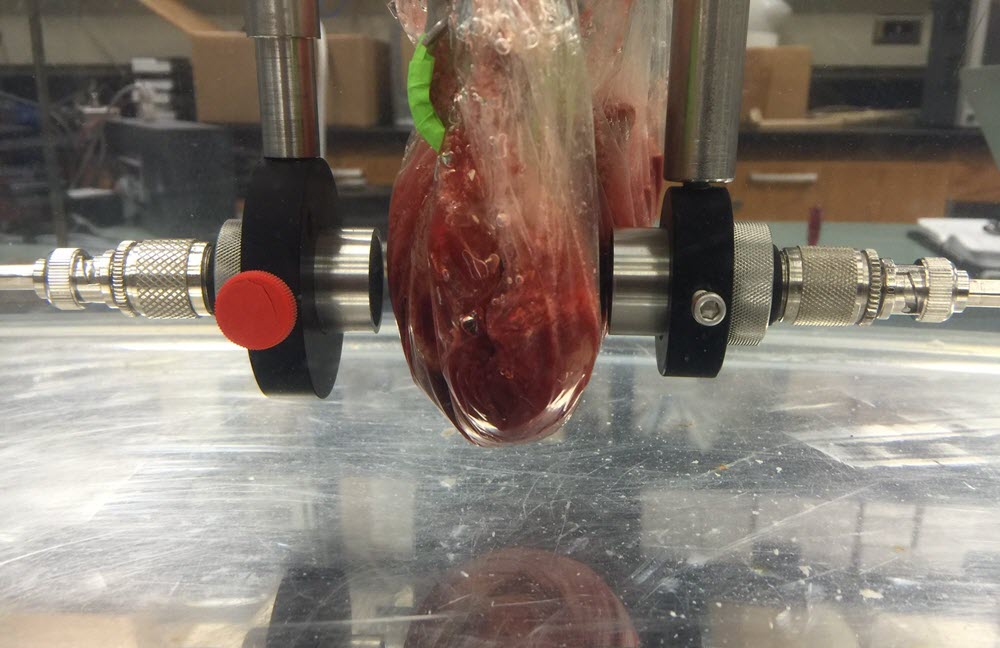Ultrasound allows for transmitting HD video through animal tissues
April 27, 2016

HD video transmission through human tissue from implanted medical devices via in-body ultrasonic communications: beef liver and pork loin were used to represent the density and moisture content found in human tissue (credit: UIUC)(credit: UIUC)
University of Illinois at Urbana-Champaign engineers have demonstrated real-time video-rate (>30Mbps) “meat comm” data transmission through tissue, which could mean in-body ultrasonic communications may be possible for implanted medical devices, including hi-def video.
For example, a patient could swallow a miniaturized HD video camera that could stream live to an external screen, with the orientation of the device controlled wirelessly and externally by a physician, according to Andrew Singer, the Fox Family Professor in the Department of Electrical and Computer Engineering at Illinois,
“To our knowledge, this is the first time anyone has ever sent such high data rates through animal tissue,” Singer added. “These data rates are sufficient to allow real-time streaming of high definition video, enough to watch Netflix, for example, and to operate and control small devices within the body.”
Ingestible cameras and other devices
Potential biomedical uses include ingestible cameras for imaging the digestive track, as well as lower-bandwidth devices such as implanted pacemakers and defibrillators, glucose monitors and insulin pumps, intracranial pressure sensors, and epilepsy control.
Currently, most implanted medical devices use RF electromagnetic waves to communicate through the body. The Federal Communications Commission (FCC) regulates the bandwidths that can be used for RF electromagnetic wave propagation available to implanted medical devices. For example, the Medical Device Radiocommunication Service (MDRS) designates frequencies of operation ranging from 401–406 MHz (where these is high absorption). The corresponding maximum bandwidth allowed is 300 kHz and a maximum of 50 kb/s.
The main limitation for using RF electromagnetic waves in the body is loss of signal that occurs because of attenuation in the body. That requires higher power, which can cause tissue damage from heating due to absorption.
“For underwater applications, radio-frequency (RF) electromagnetic communications has long since been supplanted by acoustic communication,” Singer noted. “Acoustic or ultrasonic communication is the preferred communication means underwater because sound (pressure) waves exhibit dramatically lower losses than RF and can propagate tremendous distances for signals of modest bandwidth.”
The study was reported in an open-access paper on arXiv.org. The researchers have received a provisional patent application on the high-definition ultrasonic technology. They will be presenting their findings at the 17th IEEE International Workshop on Signal Processing Advances in Wireless Communications, this July in Edinburgh, UK.
Abstract of Mbps Experimental Acoustic Through-Tissue Communications: MEAT-COMMS
Methods for digital, phase-coherent acoustic communication date to at least the work of Stojanjovic, et al [20], and the added robustness afforded by improved phase tracking and compensation of Johnson, et al [21]. This work explores the use of such methods for communications through tissue for potential biomedical applications, using the tremendous bandwidth available in commercial medical ultrasound transducers. While long-range ocean acoustic experiments have been at rates of under 100kbps, typically on the order of 1- 10kbps, data rates in excess of 120Mb/s have been achieved over cm-scale distances in ultrasonic testbeds [19]. This paper describes experimental transmission of digital communication signals through samples of real pork tissue and beef liver, achieving data rates of 20-30Mbps, demonstrating the possibility of real-time video-rate data transmission through tissue for inbody ultrasonic communications with implanted medical devices.